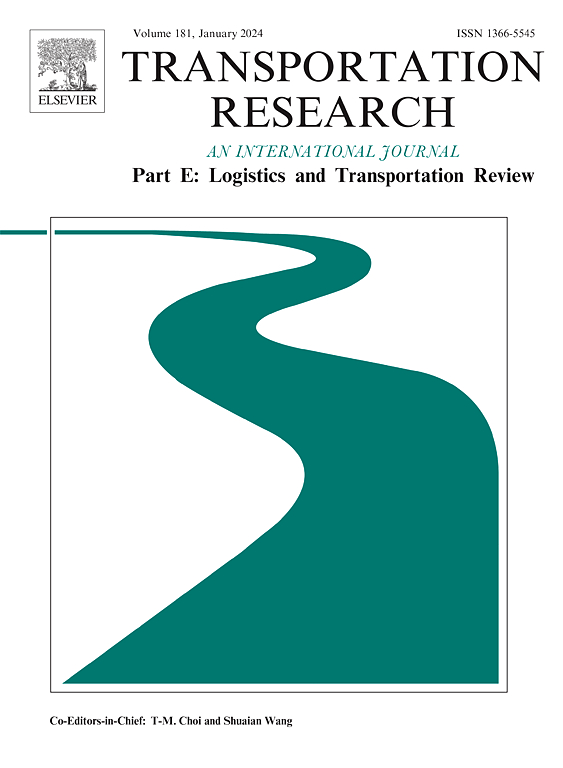考虑通用和专用服务模式的战略泊位分配定价与公平性问题
IF 8.8
1区 工程技术
Q1 ECONOMICS
Transportation Research Part E-Logistics and Transportation Review
Pub Date : 2025-10-09
DOI:10.1016/j.tre.2025.104477
引用次数: 0
摘要
港口经营者可以通过战略性地调整服务收费来吸引更多邻近港口的船只,从而提高竞争力。从港口的服务公平性和盈利能力出发,提出了一种新的以船舶为导向和以港口为导向的战略泊位分配问题(srap),以确定每个班轮承运人收取的服务费用和港口可接受的到港船舶数量。此外,还介绍了港口的两种服务模式:一种是由班轮运输公司的船舶共享总泊位并排队服务的通用服务模式,另一种是为特定班轮运输公司的船舶保留选定泊位,专门为其船舶服务的专用服务模式。通过将船舶和泊位建模为客户和服务器,我们将sbp构建为一个排队系统,该系统根据不同的服务模式具有不同的排队结构。为了实现港口利润最大化,同时保证班轮承运商之间的服务公平,通过确定合理的价格、排队结构和为各班轮承运商预留的专用泊位数量,建立了基于排队理论的双目标混合整数规划(bip)模型。为了有效地求解BMIP模型并获得Pareto边界,我们设计了一种将ε-约束方法与非支配排序策略相结合的求解方法。数值实验验证了该模型和求解方法的有效性。本文章由计算机程序翻译,如有差异,请以英文原文为准。
Pricing and equity in strategic berth allocation problem considering general and dedicated service modes
Port operators can enhance their competitiveness by strategically adjusting service charges to attract more vessels from neighboring ports. In terms of service equity and profitability of the port, a novel vessel-oriented and port-oriented strategic berth allocation problem (SBAP) is proposed to determine the service fee charged to each liner carrier and the accepted number of arriving vessels in a port. In addition, two service modes in the port are introduced: the general service where incoming vessels from liner carriers share general berths and queue for service, and the dedicated service where selected berths are reserved for a specific liner carrier, exclusively serving its vessels. By modeling vessels and berths as customers and servers, we formulate the SBAP as a queueing system with different queueing structures corresponding to each service mode. To maximize port profits while ensuring service equity among liner carriers, a bi-objective mixed integer programming (BMIP) model based on queueing theory is formulated by determining the proper pricing, queueing structure and the quantity of dedicated berths reserved for individual liner carrier. To efficiently solve the BMIP model and obtain the Pareto frontier, we design a solution approach combining the ε-constraint method with a non-dominated sorting strategy. Numerical experiments demonstrate the effectiveness of the proposed model and solution method.
求助全文
通过发布文献求助,成功后即可免费获取论文全文。
去求助
来源期刊
CiteScore
16.20
自引率
16.00%
发文量
285
审稿时长
62 days
期刊介绍:
Transportation Research Part E: Logistics and Transportation Review is a reputable journal that publishes high-quality articles covering a wide range of topics in the field of logistics and transportation research. The journal welcomes submissions on various subjects, including transport economics, transport infrastructure and investment appraisal, evaluation of public policies related to transportation, empirical and analytical studies of logistics management practices and performance, logistics and operations models, and logistics and supply chain management.
Part E aims to provide informative and well-researched articles that contribute to the understanding and advancement of the field. The content of the journal is complementary to other prestigious journals in transportation research, such as Transportation Research Part A: Policy and Practice, Part B: Methodological, Part C: Emerging Technologies, Part D: Transport and Environment, and Part F: Traffic Psychology and Behaviour. Together, these journals form a comprehensive and cohesive reference for current research in transportation science.

 求助内容:
求助内容: 应助结果提醒方式:
应助结果提醒方式:


